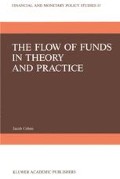Abstract
An effective monetary policy involves stability in two linkages: the linkage between the target and economic activity (“predictability”) and the linkage between the target and the policy instrument (“controllability”). The flow-of-funds framework singles out financial flows as having a closer relationship to final expenditures than interest rates or the money stock.1 Interest rate changes do not predict changes in nominal income because such variation may either signal movements in the same or opposite direction. It depends on whether or not interest rate changes are due to shifts on the demand side of credit markets or the supply side. In the case of a positive relation between interest rates and nominal income, sums raised in credit markets may be going up (indicating no policy restraint) at the same time that interest rates are going up (signaling restraint). The relationship between money and nominal income is similarly unstable. The evidence is in the search for ever wider Mi categories.2 More controversial is the question of controllability. The chapter will explore the strengths and weaknesses of money and credit targeting from the standpoint of both linkages.
Access this chapter
Tax calculation will be finalised at checkout
Purchases are for personal use only
Preview
Unable to display preview. Download preview PDF.
Notes
Targeting credit aggregates has been criticized because of their “inevitable, definitional correlation with nominal income.” (Batchelor, 1981, p. 83.) Since a theoretical framework exists for demonstrating how disturbances in credit markets are transmitted to nominal income, this criticism is more of a tribute to the credit linkage than a valid objection.
The vast literature on financial repression emphasizes the adverse economic effects of below equilibrium real interest rates on LDCs. Since the market referred to is the bank deposit market, the analysis ignores the saving leakage effect. See Cohen, 1982a, “The Myth of Indirect Finance,” pp. 11–12.
Author information
Authors and Affiliations
Rights and permissions
Copyright information
© 1987 Martinus Nijhoff Publishers, Dordrecht.
About this chapter
Cite this chapter
Cohen, J. (1987). Policy Implications. In: The Flow of Funds in Theory and Practice. Financial and Monetary Policy Studies, vol 15. Springer, Dordrecht. https://doi.org/10.1007/978-94-009-3675-1_7
Download citation
DOI: https://doi.org/10.1007/978-94-009-3675-1_7
Publisher Name: Springer, Dordrecht
Print ISBN: 978-94-010-8145-0
Online ISBN: 978-94-009-3675-1
eBook Packages: Springer Book Archive

